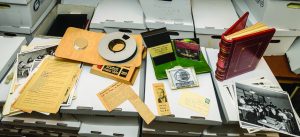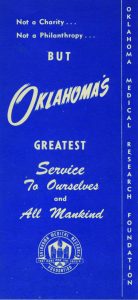by Tony Thornton
OMRF’s most important artifacts find a new home
There’s a storage room tucked behind OMRF’s Wileman Learning Center that Adam Cohen doesn’t like to think about. It’s dark and it’s dusty and it’s crammed with exactly the sort of detritus you’d imagine an organization would assemble over the course of three quarters of a century: file cabinets, unwieldy stacks of documents, and uncategorizable odds and ends. Here’s a lamp built with a piece of an actual torpedo shell, right next to an office chair with a peeling vinyl seat, right next to a collection of paintings of individuals who generally give the impression of being important but not particularly happy.
“Yeah, it’s not the ideal space to serve as a repository for OMRF’s most precious documents and photos,” says the foundation’s senior vice president and general counsel.
Still, for as long as anyone seems to remember, that’s precisely how OMRF has used the storage room.
As OMRF’s chief legal officer – and unofficial historian – Cohen had, from time to time, poked around the archives in search of this document or that. “I’d never felt great about keeping our institution’s history in what was essentially grandma’s attic,” says Cohen. His uneasiness grew more acute with preparations for OMRF’s 77th anniversary and accompanying 77 for 77 campaign.
Around that time, OMRF President Dr. Andy Weyrich took a tour of the Oklahoma History Center, which serves as a repository and showcase for the documents, photos and objects that form the backbone of the state’s past. He and Cohen talked, and the two agreed: The Center would make the perfect home for OMRF’s archives.
“We’re proud of our history, and we want to preserve it,” says Weyrich. “We also want to share it, because we believe OMRF is an important part of our state’s story.”
OMRF put out feelers to the Oklahoma Historical Society, which maintains the state’s archives at the History Center. The Historical Society’s response was swift and enthusiastic.
“This collection will fill a considerable gap,” says Mallory Covington, who oversees archival collections for the Historical Society. “Our goal is to include all aspects of Oklahoma’s history, but until now we had very little representing medical research.”
In a series of meetings, the two organizations sketched out a plan: OMRF would deed the entirety of its archives to the Historical Society, which would then catalogue and archive those photos and documents. The process would culminate with the creation of a digital, online iteration of OMRF’s archives, which, along with all of the state’s other collections, would be available to – and fully searchable by – the public.
For Weyrich, that last part was crucial. “At OMRF, we have always thought of ourselves as belonging to the entire state,” he says. “Now, every Oklahoman will be able to access and learn about their medical research foundation.”
Earlier this year, the first 40 or so boxes of items made their way from OMRF to the History Center, which sits across Lincoln Boulevard from the State Capitol. Another tranche will soon follow, ready to greet a newly hired library science graduate student who will perform the lion’s share of the archiving under Covington’s guidance. The project will be underwritten by the Puterbaugh Foundation, a longtime OMRF supporter.
 Puterbaugh Foundation President Justice Steven Taylor describes the project as “a perfect fit” for the McAlester-based philanthropy, which was created by coal magnate J.G. Puterbaugh, OMRF’s second president. “Mr. Puterbaugh would approve of a gift that preserves the archives and the history of a place he dearly loved,” says Taylor.
Puterbaugh Foundation President Justice Steven Taylor describes the project as “a perfect fit” for the McAlester-based philanthropy, which was created by coal magnate J.G. Puterbaugh, OMRF’s second president. “Mr. Puterbaugh would approve of a gift that preserves the archives and the history of a place he dearly loved,” says Taylor.
Like Puterbaugh, many other key figures in state history – Robert S. Kerr, Dean McGee, Fred Jones, E.K. Gaylord – played vital roles in the foundation’s formative years. For Laura Martin, the Historical Society’s deputy director of research, that underscores the value of the collection’s addition. “These OMRF archives provide more background on some of the people who were influential in advancing Oklahoma and one of its key institutions,” she says.
There’s no timeline yet on when the project will be complete. However, the Historical Society provided a preview on Aug. 27, when it unveiled a year-long display of OMRF documents and photos at a celebration at the History Center marking the culmination of OMRF’s 77 for 77 campaign.
Cohen, for one, says he’s already resting easier knowing the collection is in good hands. “At OMRF, our medical research is indisputably world class. But our archiving skills?” He rolls his eyes and shakes his head. “Not so much.”
—
Read more from the Summer/Fall 2024 issue of Findings



